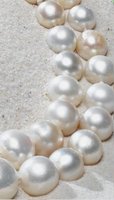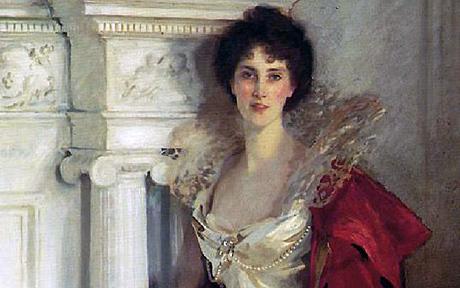Rare Natural Pearls
Natural Pearls born of the sea are extremely rare. Only 1 pearl in 1 Million will produce a Natural Pearl of gem quality. No need to go diving into the Persian Gulf though for information on these gem pearls. Dive into this page on Antique Jewelry Investor instead and learn all about pearls. Natural Master Pearl emits a nacre burst of moonbeam light, hotter than the cold surface of any faceted gemstone. You see, this is because Natural Pearls are All nacre. There is no bead nucleus inside.
 Elizabeth Taylor wearing La Peregrina Natural Pearl, one of the most famous pearls in the world.
Elizabeth Taylor wearing La Peregrina Natural Pearl, one of the most famous pearls in the world.- Natural Pearls are formed without human intervention of any kind.
- Composed entirely of nacre. A combination of aragonite and an organic binder called conchiolin.
- Wild oysters produce Natural Saltwater Pearls. Of those Pearls, only a very small amount will produce a pearl of gem quality.
- Gem quality Natural Pearls are rare.
- Nacre building takes years. The larger the Pearl, the more layers of nacre have been added.
Question: How are Natural Saltwater Pearls formed.
Answer: In an effort to protect itself from an intruder, the oyster coats the irritant with layers of nacre, also known as mother-of-pearl, the same substance it uses for shell-building. Like all mollusks, pearl oysters react to foreign objects that lodge against their soft inner body where it cannot be expelled.
To ease this irritant, the oyster begins to secrete nacre, a smooth, hard crystalline substance around the object in order to protect itself. As long as the irritant remains within its body, it will continue to secrete nacre around it, layer upon layer. Over time, the irritant will be entirely encased by the silky crystalline coatings.
When people say a string of Pearls is perfectly matched, they think the Pearls are matched for size and shape. Any jeweler's apprentice can match a Pearl for size and shape. This is basic maths.
The secret is that you match Natural Pearls, such that all the Pearls in the string of Pearls age at the same rate. This isn't so easy, because if one Pearl changes color before the rest, it will decrease the value of the Pearl necklace. Matching Pearls is not a science, it's an art.
Pearls rank low on what is known as the Mohs Scale of Hardness, so keep Pearls away from other types of Jewelry, and protected from dust particles. Perfume and common dust are a Pearl's worst enemy. All types of Pearls, Natural, Cultured Saltwater Pearls, and Freshwater Pearls can be easily damaged by minerals in dust and chemicals in perfume.
Dust contains tiny particles of quartz, a mineral much harder than Pearl on the Mohs hardness scale. Over time the quartz in the dust particles will scratch and age a Pearl
Some people are born with an eye for a Pearl. But even experience in the trade is not enough. Some people seem to have what others cannot learn, the gift of knowing. They are born with an eye for a Pearl, as some people are born with a gift for music or art.
Natural Pearls are One in 1 Million
 Pearls at Court Pearls at Court |
From the list of gemstones born of the earth, it is the Natural Pearls, born of the sea, I find the most interesting. Perfect at birth, their natural beauty needs no improvements, and their qualities are far more subtle than the cold surface of any faceted gemstone.
Pearl connoisseurs who understand how to invest money in Pearl, know that while other precious gemstones receive careful treatment from the lapidary, and owe much to his art, the wild Natural Pearl is born free. It owes nothing to man; a true gift of nature.
A variety of Natural Pearls, saturated with incomparable blue color is the ice-blue Pearl - a Natural Abalone Pearl.
The two supreme marine Pearl necklace masterpieces in the world are the Baroda Pearls, (photo above) formerly owned by the Maharaja of India and La Peregrina Pearl with its classic pear-shaped body. La Peregrina was acquired by Richard Burton for Elizabeth Taylor, who passed away on March 23rd, 2011 aged 79 years.
Throughout the ages, little Pearls have denoted purity and elegance. Pearl is the talisman wedding gem and anniversary stone for a traditional 30th wedding anniversary.
If you would like to own a Natural Pearl, consider Investing in Georgian Jewelry. as you may be lucky enough to find one or two natural marine Pearls among fine Antique Jewelry of that period.
If you would like to understand how to care and clean Pearls, Information on How to Clean and Care for Pearls can be Found Here....
Many Jewelry love affairs start out with a good book like The Pearl by John Steinbeck. Ever since reading the book, my love for Natural Pearls has just increased.
This "Pearl of Pearls" is a rare find indeed. If you get the opportunity to hold one of these little Pearls in your hand, all Nacre inside and no nucleation required, it is a great privilege.
And what can one say of the very large Pearls, which are larger than even the Australian South Sea Pearl? The Giant Dubai Saltwater Pearl and the aragonite Pearl specimens are so large they're considered to be freaks of nature, rather than accidents of nature. See also the Arco Valley Pearl - The Second Largest Pearl in the World.
Master Pearl & Master Paintings
 Natural Pearl Earrings & Necklace (Artist Unknown) Natural Pearl Earrings & Necklace (Artist Unknown) |
 Girl with a Pearl Earring by Johannes Vermeer Girl with a Pearl Earring by Johannes Vermeer |
Master Pearl has captured the heart of more than one master painter who has immortalized their natural beauty on canvas. The famous painter, John Singer Sargent (b.1856), who painted Belle Époque beauties including the Duchess of Portland, 1864-1954), had an eye for Pearls. Singer Sargent painted a full-length standing portrait of Winifred, Duchess of Portland in 1902 (see image above and reference at end of this page). She is wearing a long white ankle-length satin gown, with lacy stiff standing collar, and red velvet cloak. Below her bosom, strands of Pearls festoon across her corsage from a diamond and Pearl brooch.
It the same brooch the Duchess wore with her coronation robes five years earlier at the 1897 Devonshire House Costume Ball, in celebration of Queen Victoria's Diamond Jubilee. Sargent used seven brushstrokes to paint each pearl, and with each stroke he used a pigment of a different color. This technique created a realistic painting of a single round pearl white.
An earlier artist with an eye for Pearls, was the seventeenth-century Dutch master, Johannes Vermeer, whose masterwork, 'Girl With the Pearl Earring' captures the precise realism of Natural Pearls.
The Natural Pearl Equation
The actual body color is no part of the Pearl connoisseur equation, according to Richard W. Wise, author of "Secrets of the Gem Trade."
"No particular hue or color of a Pearl is more beautiful than another." What Richard describes as "Simpatico", is what's more important. Simpatico in this sense means that the color is compatible with the skin of the wearer.
Identifying and Matching Pearls isn't easy, but there are inconclusive Natural Pearl tests. Grading Natural Pearls can be as simple as it is complex. Japanese Pearl divers and old-timers would look primarily at their Shape, Symmetry, Skin, and Complexion. The complexion is compared to a Pearl's lustre. The lustre and its delicate play of color depend upon the perfection of the Pearl's surface.
Under careful Jeweler's Loupe magnification you can see the surface of a Pearl is delicately rippled. When light strikes the ripples, it refracts into a play of colors. This delicate play of colors depends upon the perfection of the pearl's surface, causing light to reflect from the overlapping platelets of aragonite. The iridescence comes from the light striking up at different angles from the rippled layers.
The oyster secretes the nacre which builds up the Pearl layers, like the inside of an onion, and the reflection from the buried surfaces through the outer transparent layers determines the beauty of the gem.
The quality of the nacre depends on the positioning inside the shell. The most perfect gems are found in the softest parts of the oyster.
Latitude, meteorology, sea conditions, nature of plankton in the surrounding area, the soil of the ocean floor, genetic originality of its mother, and the health of the oyster all determine the quality of a Natural Pearl.
Due to overfishing and pollution, unfortunately Pearl stocks are depleted. Only about half of one per cent of the world's Pearls are Natural. Most gem Pearls are recycled from the past, and tend to gravitate towards the world's treasuries, changing hands among private collectors. Being so rare, very few genuine Natural Pearls are available on the open market.
See K.C. Bell, Pearl expert, talking historic Pearl...
References:
http://www.telegraph.co.uk/culture/art/art-news/8115770/Diamond-brooch-captured-in-John-Singer-Sargent-painting-to-go-under-hammer.html
Have You Seen The Jewel-of-the-Month Yet?
Return to the top of Natural Pearls
Return to Antique Jewelry Investor Home Page


